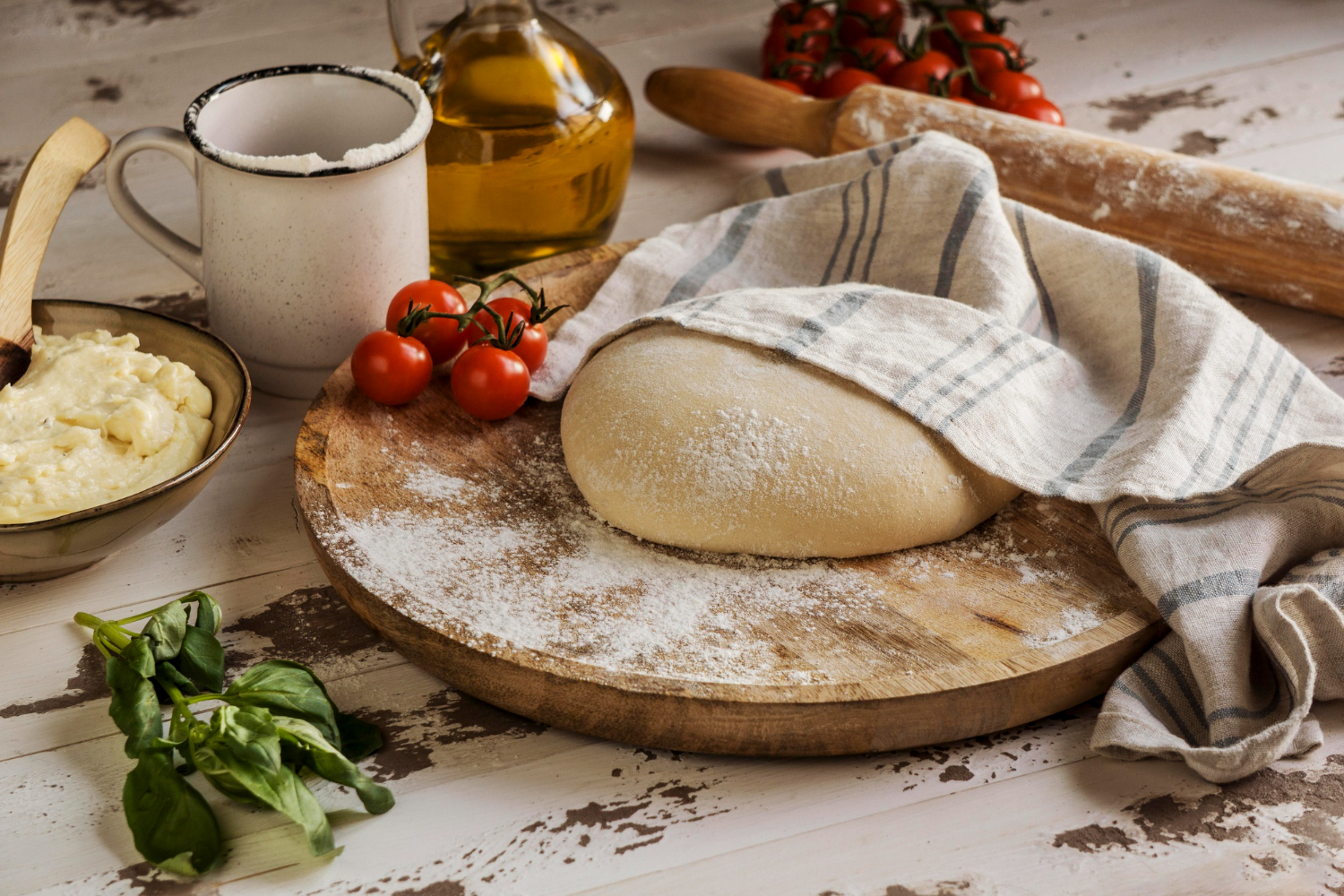How to Master Proper Bench Rest for Sourdough: A Complete Guide
Did you know that 78% of home bakers struggle to achieve that perfect, artisanal sourdough texture?
The secret isn’t in the ingredients or scoring technique. A vital step that many of us rush through – the bench rest – makes all the difference. This pause between shaping and baking determines whether you’ll get a dense, chewy loaf or one with that coveted open crumb structure every baker dreams about.
Our home kitchen has been a testing ground for proper bench rest techniques. We’ve learned through countless hours of experimenting with temperature variations and high-hydration doughs. This step can reshape the scene from good sourdough to great sourdough. Once you grasp these fundamentals, you’ll never face dense, poorly shaped-loaves again.
Want to improve your sourdough skills? Let’s examine proper bench rest timing, techniques, and troubleshooting tips.
Understanding the Science of Bench Rest
Let’s explore the fascinating science behind bench rest, a significant step in transforming your sourdough from good to exceptional. Understanding why it happens helps us make better decisions during the baking process.
How Gluten Networks Relax
During bench rest, the gluten network we’ve developed through mixing and folding enters a state of relaxation. Think of it as giving your dough a spa treatment – the tight, elastic gluten strands gradually unwind and become more pliable. This relaxation helps us shape our dough without fighting against resistance that could tear the carefully developed structure.
Role of Temperature and Humidity
Temperature plays a pivotal role in bench rest effectiveness. The sweet spot lies between 76-78°F (24-26°C), where wild yeast and bacteria perform their best work. At these temperatures, the dough maintains optimal extensibility while continuing gentle fermentation. Higher temperatures can speed up the process but risk overrelaxation. More excellent conditions need more extended rest periods.
Protein Structure Changes During Rest
This vital pause triggers remarkable changes at the molecular level. The protein structure undergoes what we call a “controlled unwinding” process:
- Original relaxation phase
- Gluten strand realignment
- Formation of new bonds
- Development of extensibility
This transformation creates the foundation for the perfect final shape. The dough’s enzymes continue their work and gradually strengthen the gluten network, preparing it for its final shape and eventual rise in the oven.
Note that a well-executed bench rest isn’t just about waiting – it gives our dough time to balance strength and extensibility.
Visual Indicators of Proper Bench Rest
Becoming skilled at spotting visual signs of proper bench rest has changed our sourdough baking experience. Watching our dough proves just as necessary as timing it.
Surface Texture Changes
Our dough observation during bench rest reveals specific surface transformations. The dough should develop a slightly taut, stretched appearance on top. Properly rested dough becomes soft and pillowy, with a smooth surface but not overly tight. These visual cues tell us what to look for:
- A smooth and soft look
- A surface with slight stretch and tautness
- Texture that stays consistent
- Air bubbles you can barely see
Dough Movement Patterns
We found that properly rested dough shows distinct movement characteristics. A gentle touch should make it feel alive and responsive, like a perfectly filled water balloon. The dough appears jiggly from trapped gasses but maintains enough structure to hold its shape.
Testing Dough Readiness
The poke test serves as our quickest way to check dough readiness. Here’s our proven technique:
- Gently poke the dough with a floured finger
- Watch how the indentation responds
- Perfect readiness: The indent slowly springs back but doesn’t fill in
- Under-rested: The dough springs back quickly and completely
- Over-rested: The indent remains unchanged
We look for that sweet spot where the dough feels aerated and jiggly but not too full of air to become fragile. Properly rested dough should feel soft and extensible, ready for its final shaping.
Mastering Bench Rest Timing
Our baking experience has shown that perfect bench rest timing combines art and science. Let’s explore how to become skilled at this vital step in your sourdough experience.
Simple Time Guidelines
The dough must rest between 10 to 45 minutes based on how tightly we shape it. Here’s our tested approach:
- Start with a 20-minute baseline rest
- Check dough consistency at 15 minutes
- Extend rest time if dough feels tight
- Proceed with shaping when the dough spreads slightly
Adjusting for Dough Hydration
Hydration levels substantially affect bench rest timing. Higher hydration doughs (above 75%) need shorter rest periods because they relax faster. These wetter doughs need 15-20 minutes of rest time. Lower hydration doughs need longer rests and often require 45 minutes to achieve optimal extensibility.
Effect of Room Temperature
Temperature changes bench rest timing. Our observations show:
- Warm environments (80°F/27°C): Reduce rest time by 25-30%
- Cool environments (65-70°F/18-21°C): Extend rest time by up to 50%
- Standard room temperature (72-75°F/22-24°C): Follow simple guidelines
Note that fermentation continues during the bench rest period. In warmer conditions, the dough can increase in volume by up to 10% during this phase. Room temperature remains a critical factor in determining the final rest time.
Troubleshooting Common Issues
Our sourdough experience has taught us about many bench-rest challenges. During this significant stage, let’s learn how to spot and fix common problems.
Over-rested Dough Signs
Over-rested dough shows clear warning signs. These indicators will help you identify the issue:
- The dough spreads too much when touched
- The surface becomes too soft and sticky
- Dough feels fragile, and tears easily
- Outer skin loses tension
- Large, irregular bubbles appear
Under-rested ProblemsUnrested dough can create just as many issues. The dough stays tight and resistant and fights back during shaping, usually leading to a dense, gummy crumb texture and poor oven spring. A quick test shows the dough springing back right after shaping—this clearly shows that gluten needs more relaxation time.
Emergency Recovery Tips
These proven recovery steps help us handle bench rest issues:
Over-rested dough fixes:
- Shape gently with minimal handling
- Cut final proof time by 15-20%
- A cooler environment helps
Under-rested dough solutions:
- Add 10-15 minutes more bench rest
- Keep temperature warm (75-78°F)
- Use the gentle poke method to test again
We found that consistent temperature and humidity levels prevent most bench rest problems. A well-floured banneton correctly supports shaped loaves and helps maintain dough integrity even if the optimal bench rest window is slightly missed.
Conclusion
A proper bench rest is the lifeblood of exceptional sourdough baking. Our extensive testing and hands-on experience show that this significant step changes ordinary loaves into bakery-worthy creations.
Your dough’s signals guide the path to success. Perfect bench rest combines science, timing, and careful observation. You must watch those telltale surface changes and adjust rest periods based on temperature and hydration levels.
Most bakers rush through bench rest without understanding its vital role in developing proper structure and texture. Patience during this stage leads to better oven springs, improved crumb structure, and a perfect balance between crust and interior texture.
Want to improve your sourdough skills? Raise your bread and pizza game with an authentic artisanal sourdough starter from The Yeast We Can Do. Our small-batch starter helps create exceptional bread and pizza with perfect tangy flavor and signature crust. This applies whether you’re a passionate home baker or a restaurant owner who wants to add true sourdough’s unmistakable flavor and character to your menu. You can start creating outstanding bread today by emailing john@theyeastwecando.com to get our premium sourdough starter.
These bench-rest techniques require consistent practice. Pay attention to your dough’s needs, and your sourdough baking will reach new heights. You’ll become skilled at this vital step and create outstanding loaves that would make any artisan baker proud.
FAQs
How long should the bench rest for sourdough be? The ideal bench rest time for sourdough typically ranges from 10 to 45 minutes. For a standard sourdough recipe with moderate hydration, aim for about 30-40 minutes. The duration depends on factors like dough hydration, room temperature, and how tightly you’ve shaped the dough.
Should I cover the dough during bench rest? Yes, it’s recommended to cover your dough during bench rest. This prevents a hard crust from forming on the surface, which could interfere with the final shaping and oven spring.
How can I tell if my dough is adequately rested? Use the poke test to determine if your dough is adequately rested. Gently poke the dough with a floured finger. Your dough is ready if the indentation slowly springs back but doesn’t fill in. If it springs back quickly, it needs more rest time. If the indent remains unchanged, it may be over-rested.
How does hydration affect bench rest time? Higher hydration doughs (above 75%) typically need shorter rest periods, around 15-20 minutes, as they relax more quickly. Lower hydration doughs often benefit from longer rests, sometimes requiring 45 minutes to achieve optimal extensibility.
What impact does room temperature have on bench rest? Room temperature significantly affects bench rest timing. In warm environments (around 80°F/27°C), rest time is reduced by 25-30%. In more relaxed environments (65-70°F/18-21°C), extend rest time by up to 50%. At standard room temperature (72-75°F/22-24°C), follow basic guidelines.
What are the signs of overrested dough? Overrested dough exhibits excessive spreading when touched, becomes overly soft and sticky, feels fragile and tears easily, loses tension in the outer skin and may develop large, irregular bubbles.
How can I fix under-rested dough? If your dough is under-rested, return it to bench rest for a0-15 minutes in a warm environment (75-78°F). Then, test again using the gentle poke method to check for readiness.
How long should sourdough cool before cutting? Allow your sourdough bread to cool completely to room temperature before slicing. This can take a few hours or even overnight. Patience during this cooling period helps develop the bread’s flavor and texture.
What visual cues indicate proper bench rest? Look for a smooth, soft appearance with a slightly stretched, taut surface. The dough should have an even, consistent texture with visible but subtle air bubbles. It should feel alive and responsive when gently touched, similar to a perfectly filled water balloon.
Can I adjust bench rest time for different types of sourdough recipes? Adapting bench rest time based on your recipe, dough hydration, and ambient conditions would be best. Start with the basic guidelines and fine-tune based on how your dough responds, always using visual cues and the poke test to determine readiness.






